How Do I Choose a Slewing Bearing?
Slewing bearings, also known as slew bearing or slewing ring bearings, facilitate pivotal movement in machinery, handling axial, radial, and moment loads simultaneously. They are essential for 360-degree movement in heavy machinery and precision equipment. The blog post "How Do I Choose a Slewing Bearing?" guides you in selecting the right bearing. It covers bearing types, structures, key factors like load capacity and rotational speed, and tips for sizing, material selection, installation, and maintenance.
Understanding Slewing Rings
What Is a Slewing Bearing?
A slewing bearing is a type of bearing designed to support and transmit high loads while allowing rotational movement.
Components of a Slewing Bearing
- Inner and Outer Rings: Form the main structure, with rolling elements in between.
- Rolling Elements: Balls or rollers that enable rotation and distribute loads.
- Spacers or Cages: Guide and separate the rolling elements.
- Seals: Shield the bearing from contaminants.
- Mounting Holes: Secure the bearing to machinery.
- Lubrication: Allows regular maintenance for smooth operation.
- Optional Features: Gears for rotation or coatings for durability.
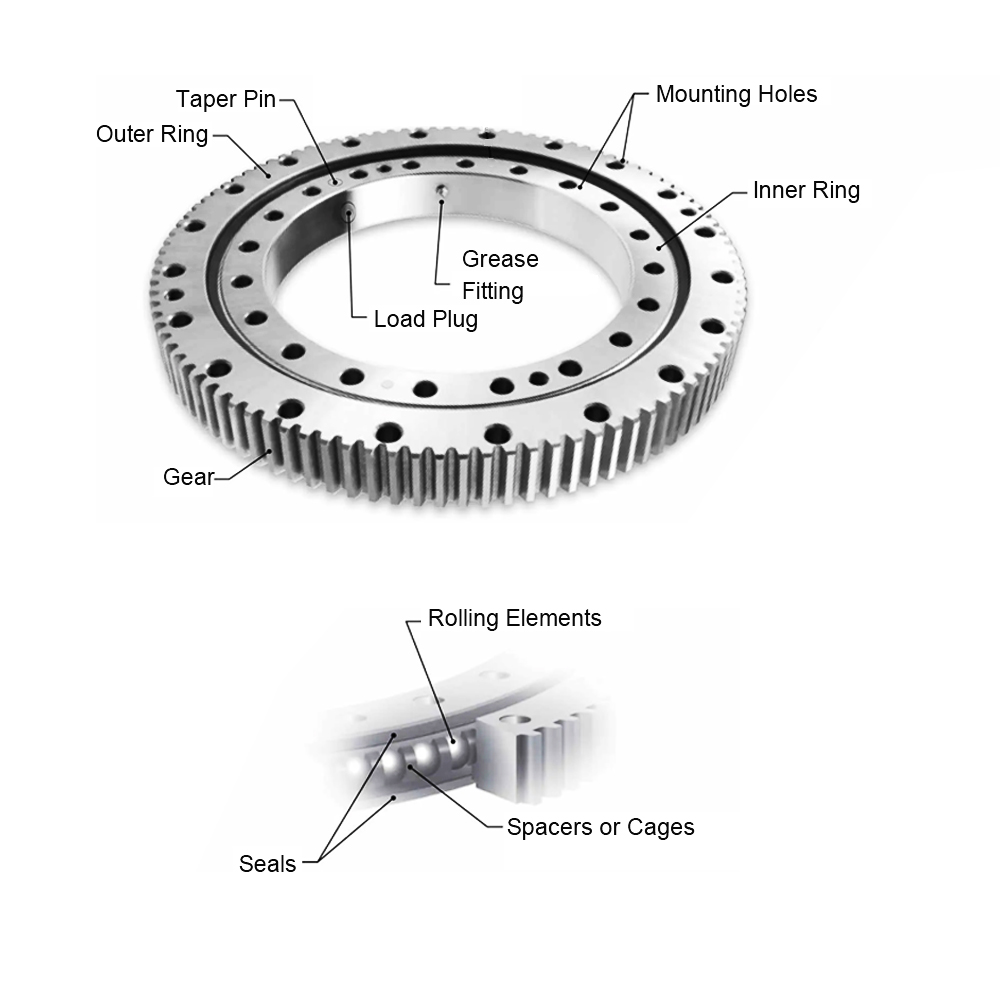
Types of Slewing Rings
| Type | Description |
| Four Point Contact Ball Slewing Ring Bearing | Balances axial, radial, and moment loads. |
| Eight Point Contact Ball Slewing Ring Bearing | Enhanced load capacity for heavy-duty use. |
| Cross Roller Slewing Ring Bearing | Supports all load types with high precision. |
| Three-Row Cross Roller Slewing Ring Bearing | Separates and increases load capacity. |
| Thrust Ball Slewing Rings | Specialized for high axial loads. |
| Combination Slewing Rings | Combines ball and roller for balanced support. |
| RealiSlim TT Turntable Bearings | Compact, ideal for space-limited applications. |
| Mating Pinions | Enables powered rotation. |
| Slewing Ring Bearings In Transport Vehicles | Provides smooth rotation and support for loads in transport applications. |
Slewing Bearing Application
Slewing bearings, including slewing gear bearings, are essential in a wide variety of applications. Here's an overview of their key uses:
- Cranes
- Wind Turbines
- Medical Equipment
- Robotics
- Transport Vehicles
- Construction Equipment
- Industrial Machinery
Factors to Consider When Selecting a Slewing Ring
Load Types and Calculation
- Slewing bearings support various load types, essential for machinery function:
- Axial Loads: Affect the bearing's vertical support, especially in the case of turntables bearings.
- Radial Loads: Impact its horizontal support.
- Moment Loads: Create a tilting force, leading to bending.
- Calculating these loads involves formulas considering weight, distance, and angles, ensuring the bearing meets operational requirements.
Theoretical Loading Analysis
Evaluates bearing capacity, focusing on:
- Material Choice: Influences strength and capacity.
- Raceway Heat Treatment: Increases hardness and load capability.
- Bearing Dimensions: Larger sizes can bear more weight.
Actual Loading Analysis
Verifies performance and safety:
- Interference and Fits: Ensures no deformation or failure.
- Fit Standards: Adhering to ANSI standards prevents misalignment.
- Material Choices: e.g. LILY Bearings' 50MN design provides robustness and cost-efficiency.
Rotational Speed
- The bearing must support the desired speed of rotation, factoring in operational demands.
- High-speed applications require bearings designed for smooth movement at these speeds to prevent wobble or vibration.
Precision
- For applications requiring high accuracy, such as medical devices or robotics, choose a slewing ring that provides precise movement with minimal deviation.
- Ensures consistency and reliability in sensitive operations.
Environmental Conditions
- Consider the operating environment, including temperature variations, humidity, and potential exposure to contaminants.
- Select a slewing ring that can endure these conditions, and consider bearing seals or coatings for additional protection.
Cost Considerations
- Balance quality and budget requirements by comparing different slewing ring designs and materials.
- Consider the total cost of ownership, including installation, maintenance, and replacement costs.
Supplier Capabilities
- Choose a supplier with proven expertise and the ability to meet custom specifications.
- Evaluate their quality control standards, manufacturing capacity, and after-sales support.
- Ensure they can deliver consistent and reliable products on time.
Step-by-Step Guide to Choosing the Right Slewing Ring
Step 1: Identify Equipment Requirements
Determine the equipment requirements, including:
- Load: axial, radial and moment load;
- Speed: maximum and average rotational speed;
- Accuracy: positional, repeatability, and runout tolerance;
- Environmental conditions: temperature, humidity, contaminants, and corrosion resistance.
Also, consider operational life, space constraints, and budget to ensure the slewing ring meets the machinery's specific needs.
Step 2: Calculate Maximum Bearing Loads
- Identify the maximum bearing loads, including both dynamic and static loads on the slewing bearing.
- Consider all forces acting on the bearing and gear, not just at rated and working loads but also during extreme weather, impacts, testing, assembly, disassembly, and other conditions.
- Simplify these loads into the forces acting at the bearing's center.
Step 3: Apply Service Factors
Multiply the bearing forces by the service factor.
Service factors depend on the frequency of high vs. normal loads and the potential for extreme or impact loads. Customer specifications, finite element analysis (FEA), or regulations may override these factors.
If your application isn't in the following Table, use a similar one for initial sizing or consult the manufacturer.
| Application | Service Factor |
| Aerial Lift Devices | |
| - Aerial baskets, platforms, ladders | 1.00 |
| Conveyors | 1.00 |
| Cranes | |
| - Mobile (Loads Limited by Machine Stability): | |
| -- Normal Construction Duty (Tire Mounted) | 1.00 |
| -- Normal Construction Duty (Crawler Mounted) | 1.10 |
| -- Production Duty (Scrap/Ship Yards) | 1.25 |
| -- Forestry Handling (Logging) | 1.50 |
| -- Stacker Cranes (Includes Dynamic Forces as Loads) | 1.25 |
| - Pedestal or Tower (Loads Not Limited by Machine Stability): | |
| -- Loads Monitored by Safe Load Device | 1.25 |
| -- Applications with Sudden Impact Load | 1.50 |
| Excavators | |
| - Load Limited by Tipping | 1.25 |
| - Load Limited by Hydraulic Pressure Relief | 1.50 |
| Index and Turnstile Tables | |
| - Occasional Use with Intermittent Rotation | 1.00 |
| - Frequent Use with Intermittent Rotation | 1.25 |
| - Frequent Use with Intermittent Rotation and Impact | 1.50 |
| Industrial Manipulators and Robots | |
| - Occasional Service | 1.00 |
| - Frequent Service | 1.25 |
| Steering Gear (Must Include Dynamic and Shock Loads): | |
| - Pneumatic Tires | 1.25 |
| - Solid Tires | 1.50 |
Step 4: Gear Requirements
If an integral gear is required, determine the required Gear Capacity.
Consider all conditions that may generate gear loads, such as:
- Dynamic vs. static loads
- Loads on inclines
- Overload testing
- Account for the duty cycle under each condition.
Step 5: Mounting Arrangements
Determine the Preferred Mounting Arrangement:
- Consider the pinion and gear location, as well as requirements for bearing installation and ongoing maintenance of the bearing and retaining bolts.
- Slewing bearings can be designed to suit a variety of mounting arrangements.
Examples of Basic Arrangements:

Fig 1
As shown by the through bolt arrangement in Fig 1, the pinion attaches to the outer ring, supporting the upper structure via the inner ring. A shroud with bolts covers the outer seal to prevent contamination in harsh conditions.
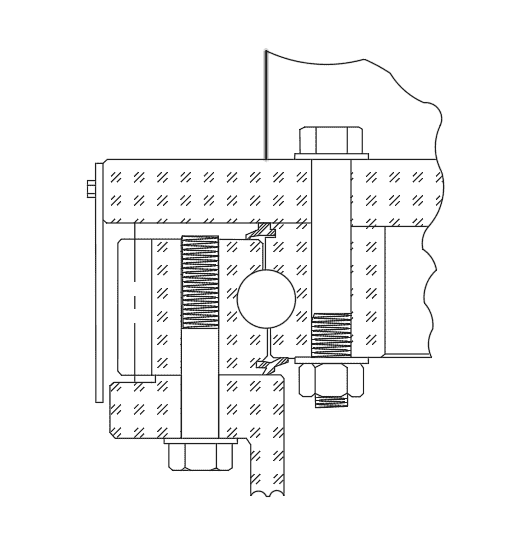
Fig 2
The upper structure, which includes the pinion, is supported by the inner ring via through bolts. Also an external shroud is in place to safeguard the gear teeth on the outer ring, which is anchored by the lower structure using threaded bolts.
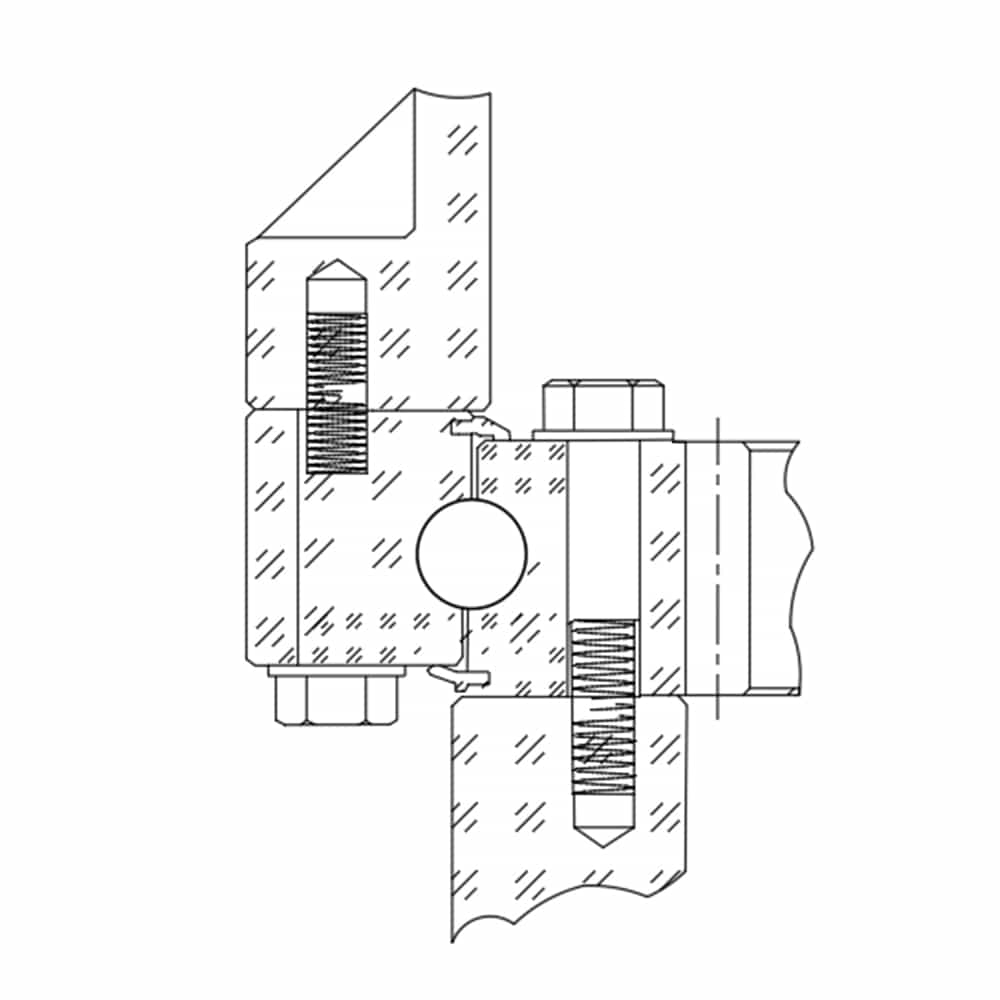
Fig 3
The pinion is connected to the upper structure, supported by the outer ring. Placing the gear on the inner ring shields it from harsh external conditions. Shown: threaded bolt arrangement.
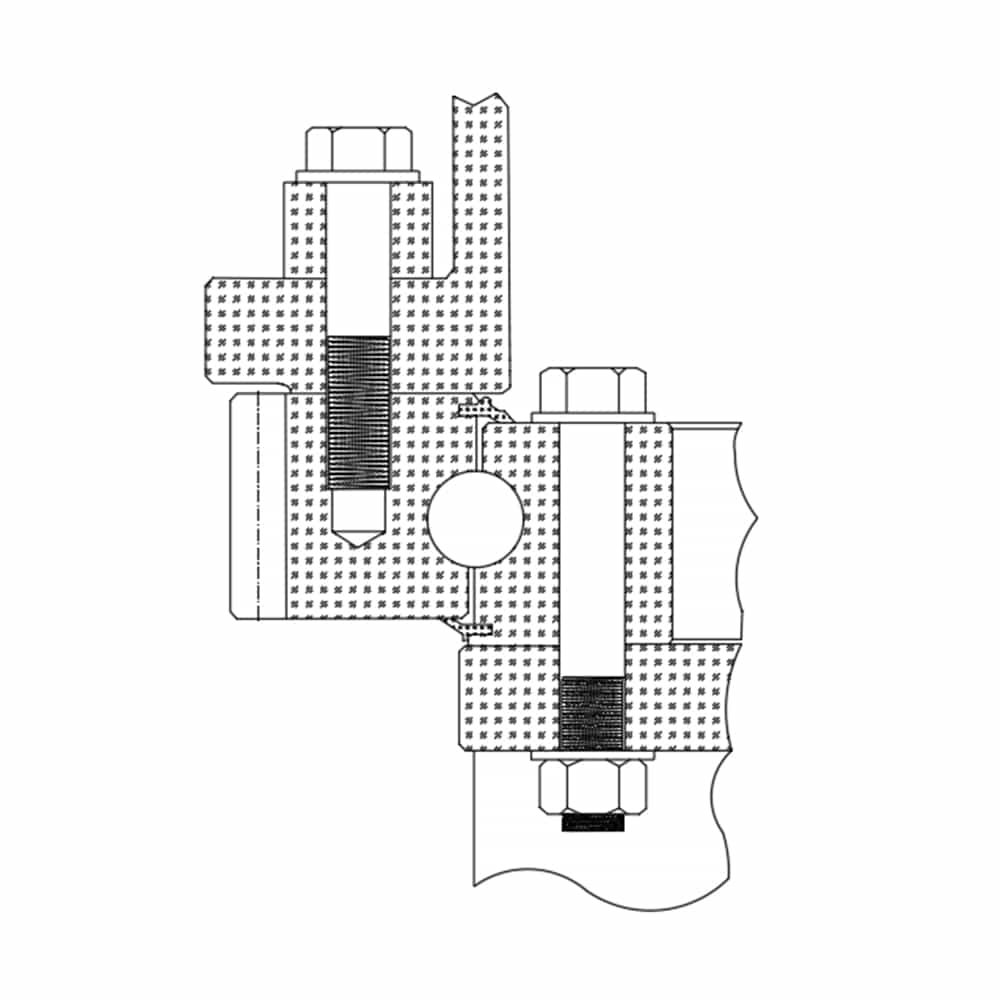
Fig 4
The pinion attaches to the lower structure, supporting the inner ring. The geared outer race holds up the upper structure. Through bolts secure the inner ring, while threaded bolts secure the outer ring.
Step 6: Review Bearing Styles and Cross-sections
Explore the different bearing styles and cross-sections. The following figure highlights some of the slewing bearing designs offered by LILY Bearing.
- RK series
The RK Series are available in geared and non-geared variants ranging from 20” to 47” OD, supporting up to 141,000 ft-lbs moment, 175,000 lbs thrust, and 35,000 lbs radial loads.
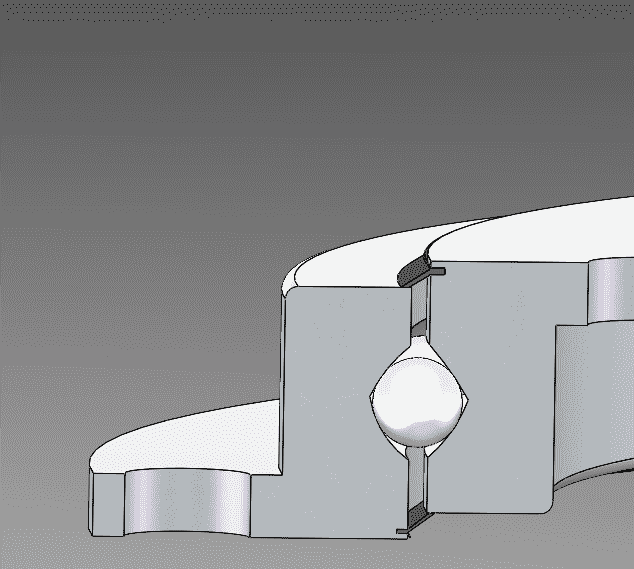
- MT series
MT Series are available up to 240” OD with moment capacities up to 10,000,000 ft-lbs, thrust up to 6,000,000 lbs, and radial loads up to 1,300,000 lbs.
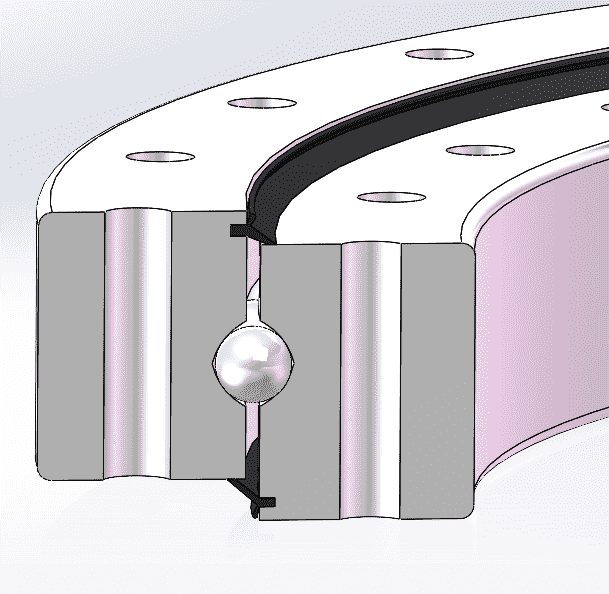
- XR series
XR Series are available in sizes up to 315” OD, in internal, external, or non-geared versions.
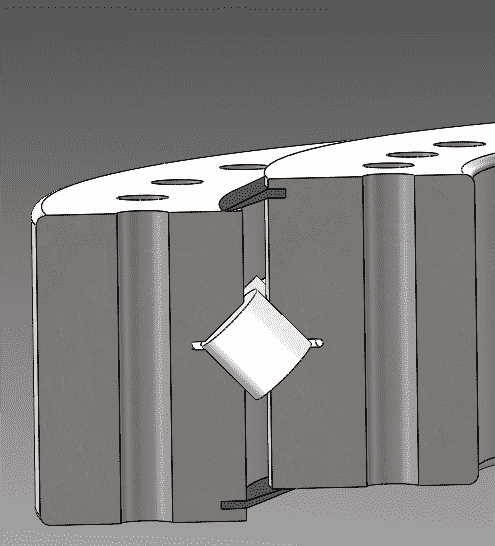
- TR series
TR Series are available in sizes up to 315” OD with moment capacities exceeding 50,000,000 ft-lbs, thrust over 18,000,000 lbs, and radial loads above 4,000,000 lbs, in internal, external, or non-geared configurations.

Step 7: Preliminary Selection of Bearing
Make a preliminary selection by comparing operating bearing forces, including the service factor, to the bearing's rating curve:
- Ensure all force combinations fall below the curve.
- Extreme loads must fall below the curve. Exclude the service factor for static loads occurring rarely; otherwise, include it.
- The maximum thrust rating should exceed 3 times the maximum operating thrust force.
Contact the manufacturer if the slewing bearing doesn't meet these criteria.
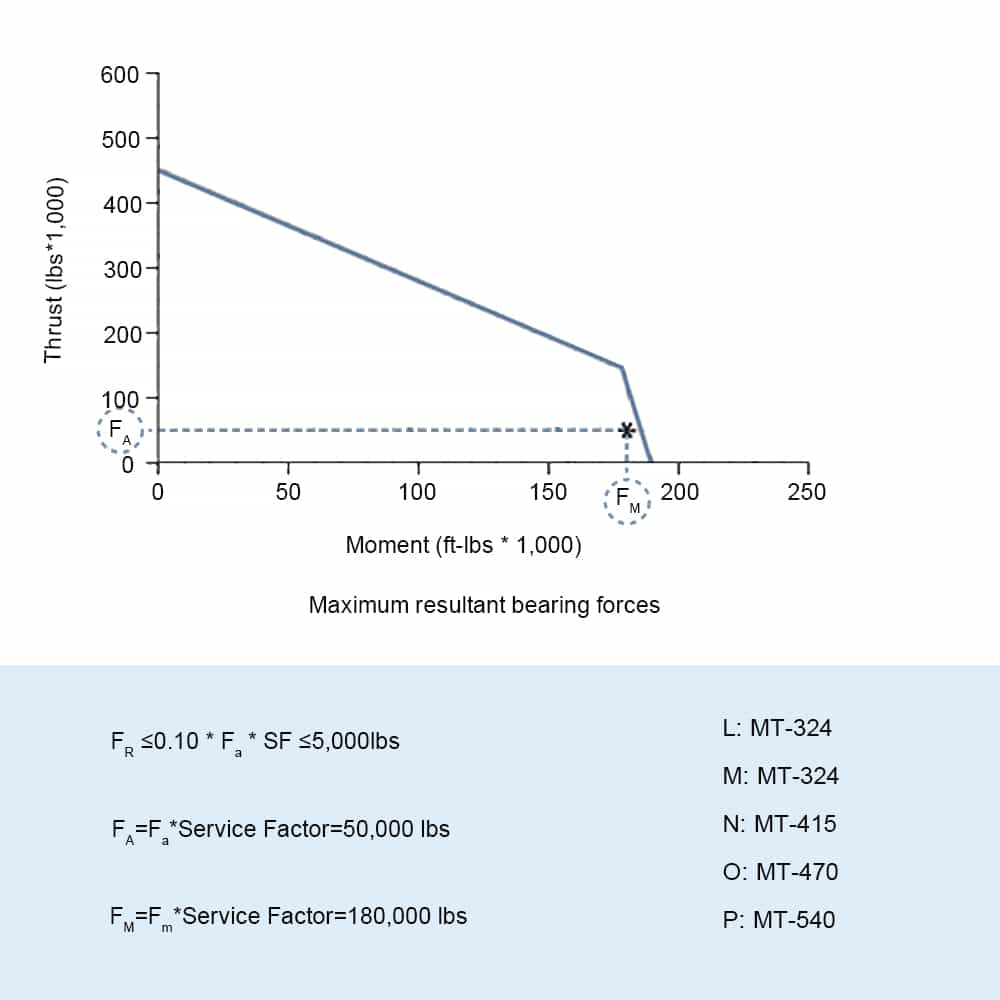
Bearing's Rating Curve
Step 8: Gear Size and Quality Check
Ensure the gear size and quality meet application requirements by verifying the following:
Module, Tooth Count, and Face Width: Match the gear dimensions to the load and torque demands.
- Material and Hardness: Ensure material strength and heat treatment meet the expected load and wear requirements.
- Quality Standards: Check compliance with AGMA or ISO standards for gear quality.
- Backlash and Accuracy: Confirm proper backlash and accuracy for smooth operation.
Step 9: Final Confirmation of Bearing Selection
Verify that the chosen slewing ring meets all load, speed, accuracy, and environmental requirements before proceeding.
Customize High-quality Slewing Bearings at LILY Bearing
Material Selection
Inner & Outer Ring
| Properties | 42CrMo4 (1.7225) | 50Mn GB/T 699 | 42CrMo GB/T 3077 |
| Chemical composition (%) |
C:0.38-0.45 Si:≤0.40 Mn:0.60-0.90 P:≤0.025 S:≤0.035 Cr:0.90-1.20 Mo:0.15-0.30 |
C:0.48-0.56 Si:0.17-0.37 Mn:0.70-1.00 P:≤0.035 S:≤0.035 Cr:≤0.25 Ni:≤0.30 Cu:≤0.25 |
C:0.38-0.45 Si:0.17-0.37 Mn:0.50-0.80 P:≤0.030 S:≤0.030 Cr:0.90-1.20 Mo:0.15-0.25 |
| Mechanical properties |
Yield strength:≥930 MPa Tensile Strength:≥1080 MPa Elongation:≥12% Hardness:≤217HB |
Yield strength:≥390 MPa Tensile Strength:≥645 MPa Elongation:≥13% Hardness:≤217HB |
Yield strength:≥930 MPa Tensile Strength:≥1080 MPa Elongation:≥12% Hardness:≤217HB |
Balls
| Properties | 100Cr6 EN ISO 683-17:2000 | GCr15-GB/T 18254 |
| Chemical composition (%) |
C:0.93-1.05 Si:0.15-0.35 Mn:0.25-0.45 P:≤0.025 S:≤0.015 Cr:1.35-1.60 Ni: - Mo:≤0.10 |
C:0.95-1.05 Cu:≤0.25 Si:0.15-0.35 O:≤0.0012 Mn:0.25-0.45 Ti:≤0.005 P:≤0.025 Al:≤0.05 S:≤0.02 As:≤0.04 Cr:≤1.40-1.65 As+Sn+Sb:≤0.075 Ni:≤0.25 Pb:≤0.002 Mo:≤0.10 |
| Mechanical properties |
Yield strength:≥590 MPa Tensile Strength:≥830-1130 MPa Elongation:≥10% Diameter:30 mm Anneal to achieve spheroidized carbides:≤207HBW Anneal to achieve spheroidized carbides and cold worked:≤241HBW |
Yield strength:≥518.42 MPa Tensile Strength:≥861.3 MPa Elongation:≥27.95% Spheroidzing annealing hardness:179-207 HBW Softening annealing hardness:≤245 HBW |
Manufacturing and Quality Control
Heat treatment is used to enhance the hardness and wear resistance of slewing bearings. Lily Bearing uses selective hardening to achieve HRc 50-60, preventing failure modes like abrasive wear, fatigue, and corrosion.
Design and Engineering
LILY Bearing ensures structural integrity by considering critical design factors to accommodate various loads without failure. Bearings are customized for specific applications, addressing unique engineering challenges to deliver optimal performance.
Assembly and Testing
The assembly follows strict quality standards to ensure each component meets requirements. LILY slewing bearings undergo load and durability testing to verify they meet performance standards.
Lubrication and Sealing Technology
LILY Bearing recommends No. 2 lithium ester grease (Great Wall) for temperatures from -20°C to 120°C, ensuring smooth operation and corrosion resistance. Choose grease based on temperature, load, and environment to prevent wear and failure.
Conclusion
Choosing the right slewing ring is crucial. This blog post "How Do I Choose a Slewing Bearing?" guides you through load requirements, gear design, and mounting arrangements. For personalized advice and quality slewing rings, contact LILY Bearing today!
Keep Learning








